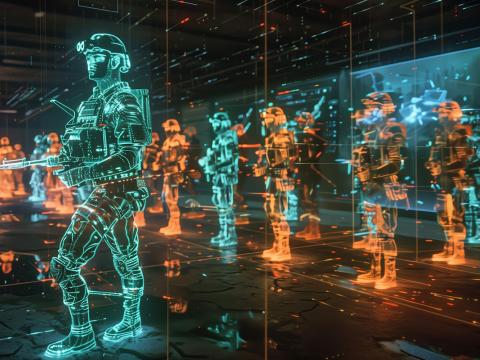Ubiquity Looms for AI, ML
The future is bright for artificial intelligence (AI) and machine learning (ML), but its crystal ball is cloudy. Much uncertainty remains both in terms of positive potential and in terms of drawbacks.
A panel of five industry and government leaders discussed what may lie ahead for AI and ML during a Women in AFCEA Panel titled, “Senior Cyber Leaders Discuss AI and ML Challenges” on day 2 of TechNet Indo-Pacific, being held in Honolulu April 11-13. The five experts explored a range of pros and cons that might define the future of AI and ML in both government and the private sector.
“AI will be everywhere in our business in a few years,” said Michele Engelhart, vice president, Defense Growth and Strategy, GDIT. She cited a host of applications ranging from business analysis to human resources, but she allowed that two applications excite her.
I’m really excited about AI and the edge. We deploy AI where the data is collected, and we do the AI at the edge.—Michele Englehart, vice president, Defense Growth and Strategy, @GDIT #AFCEATechNet
— Bob Ackerman (@rkackerman) April 13, 2022
“I’m really excited about AI and the edge,” she said. “We deploy AI where the data is collected, and we do the AI at the edge.” The other item is quantum computing, which can advance AI and do cases people have not even thought about.
From the military perspective, target recognition is a vital aspect that AI can play a major role in, said Brig. Gen. Jacqueline “Denise” Brown, USA, director, C4, USINDOPACOM. AI also can help identify communications anomalies, and it can help translate effectively in coalition operations. “Cybersecurity is where we can best use AI and ML,” she emphasized.
Cybersecurity is where we can best use AI and ML.—Brig. Gen. Jacqueline “Denise” Brown, USA, director, C4, @INDOPACOM #AFCEATechNet
— Bob Ackerman (@rkackerman) April 13, 2022
Yet potential drawbacks loom. Nicole Isoda, machine learning research and project manager, Naval Information Warfare Systems Command Pacific, warned of using AI to tell if something is compromised, if data is poisoned, or if an ML system is compromised. This is still new, she noted. Also, software engineers must use data that is representative of real-life operations when they are writing AI software.
Artificial intelligence and machine learning is not salt that you can just sprinkle on and have everything taste better.—Nicole Isoda, machine learning research and project manager, NIWC Pacific #AFCEATechNet
— Bob Ackerman (@rkackerman) April 13, 2022
AI and ML are not one-size-fits-all solutions either, panelists pointed out. “Artificial intelligence and machine learning is not salt that you can just sprinkle on and have everything taste better,” Isoda warned. Engelhart stated, “Our biggest challenge is diversity)of talent that can accept AI.” Gen. Brown said, “Our biggest challenge with AI and ML is understanding the art of the possible.” And, Catherine Johnston, deputy director for intelligence, INDOPACOM, said, “The biggest AI challenge is everything that prevents us from scaling.”
The biggest AI challenge is everything that prevents us from scaling.—Catherine Johnston, deputy director for intelligence, @INDOPACOM #AFCEATechNet
— Bob Ackerman (@rkackerman) April 13, 2022





Comments